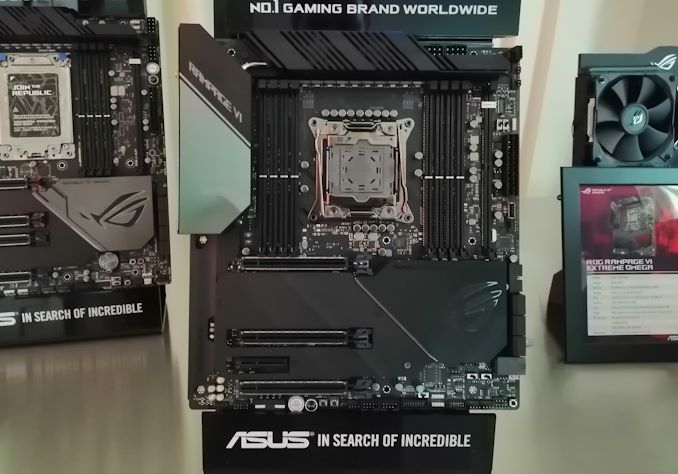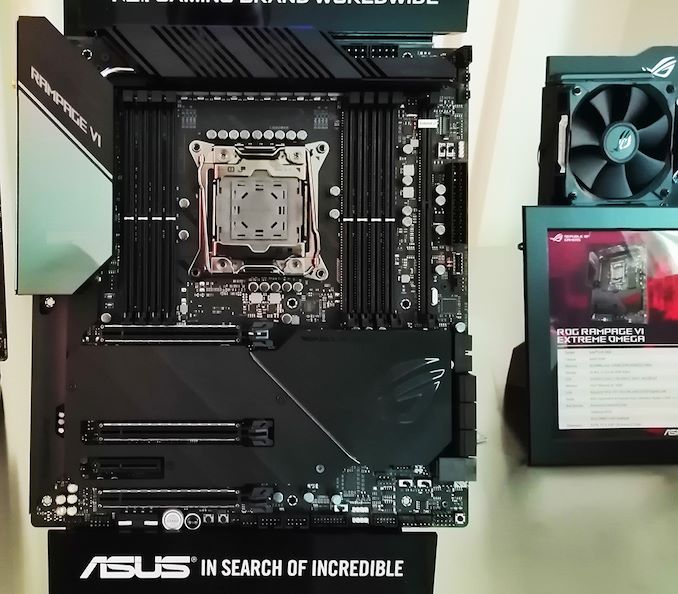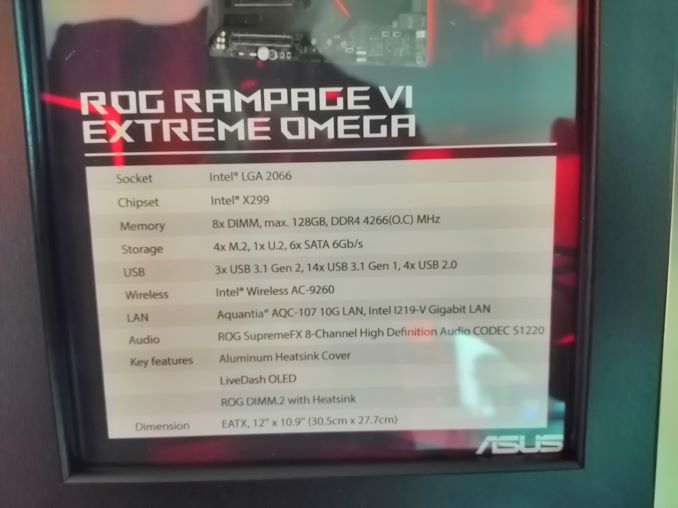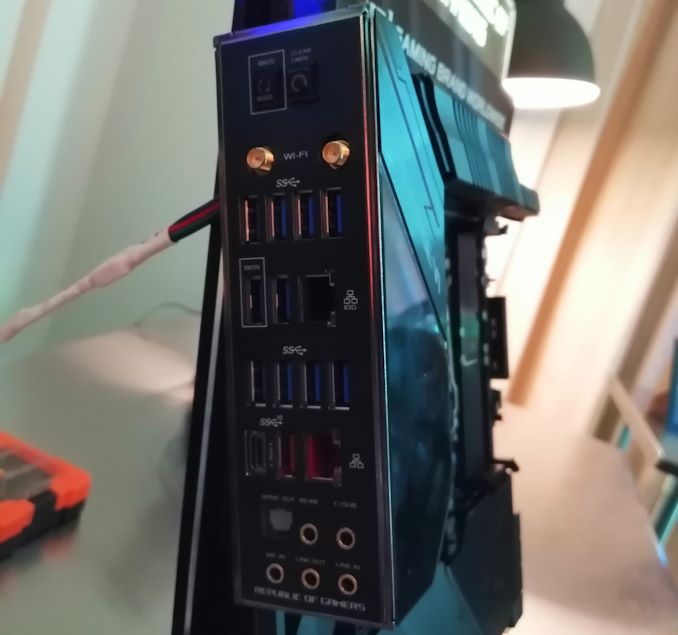CES 2019: ASUS ROG Rampage VI Extreme Omega X299 Motherboard
by Gavin Bonshor on January 14, 2019 1:00 PM EST
At CES 2019 ASUS is looking to push the boundaries of Intel Skylake-X processors even further than ever before with the announcement its ROG Rampage VI Extreme Omega X299 motherboard. This board features dual LAN, four M.2 slots and support for 3-way SLI and Crossfire setups.
The ROG Rampage VI Extreme Omega
The new ASUS ROG Rampage VI Extreme follows the release of the goliath ASUS ROG Dominus Extreme model announced for Intel 28-core Xeon W-3175X late last year. The Omega, however, is a little lighter on the surface than the Dominus Extreme and is aimed more at enthusiasts. The board has a solid feature set such as quad M.2, an Aquantia ACQ107 10G NIC, and an Intel I211AT gigabit NIC. Wi-Fi is also a notable feature, with the board supporting 802.11ac Wave2.
Visually, the majority of the bottom half of the board is covered by ROG shielding. The IO cover has an integrated ASUS AURA Sync LiveDash 1.3 inch OLED screen which allows users to monitor various elements of system performance such as core clock speed. There is also plenty of RGB too for those looking to create a unique look. The onboard RGB is located from the rear panel cover and the large ROG logo on the bottom right hand corner of the board.
ASUS has gone with a solid 8-phase power delivery consisting of 16 power stages. Providing power to these is two 8-pin 12 V ATX power connectors which are more than enough to allow maximum power than potentially needed; this is more so for extreme overclockers and those looking to push more ambitious core clock speeds.
| ASUS ROG Rampage VI Extreme Omega Specifications | |
| CPU Socket | Intel LGA 2066 |
| Chipset | Intel X299 |
| Form Factor | EATX |
| Memory Support | 8 x DDR4 (Max 128 GB) Up to DDR4-4266 |
| Multi-GPU | 3-Way SLI / 3-Way CFX |
| PCIe Slots | 3 x PCIe 3.0 x16 (x16/x16, x16/x8/x8) 1 x PCIe 3.0 x16 (x4) |
| SATA | 6 |
| M.2 | 3 x M.2 2242-22110 (PCIe) 1 x M.2 2242-2280 (PCIe) |
| USB 3.1 Gen 2 | 1 x Front 1 x Type-A 1 x Type-C |
| USB 3.1 Gen 1 | 14 |
| Networking | Intel I211AT 1 Gb Ethernet Aquantia AQC107 10 Gb Ethernet 802.11ac Wi-Fi |
The ROG Rampage VI Extreme Omega has eight memory slots offering quad channel memory support with speeds of up to DDR4-3600 and a maximum of up 128 GB. Three full-length PCIe 3.0 slots operating at x16/x16 and x16/x8/x8 allow users to use up to 3-way SLI and Crossfire multi-graphics card configurations and the majority of the PCIe PCB area is covered by a clean looking ROG panel.
Along the bottom of the PCB is an overclockers toolkit with power and reset switches, as well as a clear CMOS button and a MEMOK! button for memory overclocking. To the right just below the six SATA ports looks to be a U.2 port in addition to the four M.2 slots.
USB support is primarily focused on USB 3.1 Gen1 with the board supporting up to fourteen USB 3.1 Type-A ports with ten on the rear panel and the other four available via two front panel headers. The ROG Rampage VI Extreme Omega does include USB 3.1 Gen2 with a Type-A and Type-C on the rear panel, and also offers another port with a front panel header. The board looks to pack which is most likely a ROG SupremeFX S1220A HD audio codec. The rear panel also houses a more conveniently located clear CMOS button and a BIOS flashback button to allow users a quick and easy option to update the board's firmware.
The ROG Rampage VI Extreme Omega motherboards are set to hit the market in Q1 2019, but no pricing information has been announced as of yet.



















10 Comments
View All Comments
DanNeely - Monday, January 14, 2019 - link
Where exactly are the m.2 slots? Are they all the riser that plugs into what looks like a 7th dram slot? If not, are the remainder underneath the anti-cooling armor, or on the back of the board where the mainboard tray itself will serve a similar heat trapping function?aron9621 - Monday, January 14, 2019 - link
two are on the riser card, another two under the armordrexnx - Monday, January 14, 2019 - link
two on the riser, two under the pcie shroudPeachNCream - Monday, January 14, 2019 - link
I came in search of something incredible and left after acknowledging the presence of more of the same.ltcommanderdata - Monday, January 14, 2019 - link
https://www.asus.com/Motherboards/ROG-RAMPAGE-VI-E...So can anyone confirm that the excessively long-named ROG Rampage VI Extreme Omega doesn't support Thunderbolt 3? It certainly doesn't have it onboard and doesn't even list a Thunderbolt header for expansion card compatibility. Maybe Thunderbolt 3 isn't a general requirement for gamers, but at the price point of this ultra-premium motherboard it's hard to believe they're going to omit it. ASUS' press release calls the AMD-based Zenith Extreme Alpha and Intel-based Rampage VI Extreme Omega "two sides of the same coin" but not including Thunderbolt 3 on the Intel board just to keep feature parity and avoid disappointing AMD users is such a poor explanation.
imaheadcase - Monday, January 14, 2019 - link
Its mostly because Thunderbold itself is on the way out in favor of USB-C.HawkFest - Sunday, January 20, 2019 - link
Ridiculous, your comment doesn't seem educated : Intel's Alpine Ridge Thunderbolt controller itself encapsulates different protocols, including USB 3.1 Gen 2 (10Gbps), on top of DisplayPort and PCIexpress (as it offers a potential of 40Gbps). Which is why those motherboards offering that controller, also have the possibility to integrate additional Thunderbolt Type-C and DisplayPort ports via some expansion board pins (if not already included on the motherboard), and have their back IO ports include a Type_C connector compatible with both Thunderbolt 3 (up to 40Gbps throughput) AND with USB 3.1 Gen2 for a 10Gbps throughput.HawkFest - Sunday, January 20, 2019 - link
Also note that this type of controller would be part of the "uncore" CPU facility.Pinhead* - Wednesday, February 27, 2019 - link
Thunderbolt 3 runs on USB-C. It's a set of capabilities that are delivered via the USB-C plug and port.DanNeely - Tuesday, January 15, 2019 - link
Not listed almost certainly means not supported. Ultra premium or not, it's still an extra $30 on top; and would eat 4 PCIe lanes that could go to another m.2 slot. I suspect TB3 will remain rare even on high end boards until Intel finally un-fubars 10nm and launches its next generation CPU and Chipsets which will finally include built in TB3 support.